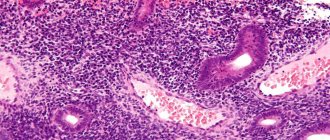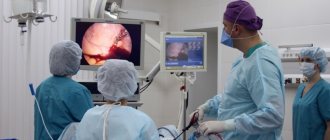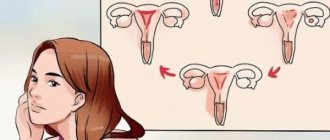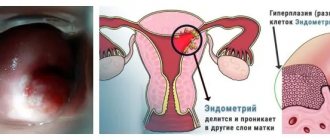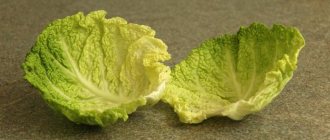Hyperplasia is a thickening of the endometrium (the inner layer of the uterus), in which hyperplastic cells actively divide and develop. The diagnosis is made when the layer thickness exceeds 16 mm. There are different forms of pathology. Depending on the type of disease, the attending physician prescribes therapy. Treatment of endometrial hyperplasia with folk remedies has long been in demand due to its simplicity, safety and effectiveness. Herbal medicine cannot be called a panacea, but as an auxiliary measure it has no equal.
General characteristics of the disease and its types
Hyperplasia is an excessive growth of the inner mucous membrane of the uterus, leading to changes in the genital tissues and disruption of the normal menstrual cycle. This disease is divided into several main types:
- glandular – pathological change in glandular tissues;
- glandular-cystic - in addition to the first type, proliferation of cysts;
- atypical - the growth of cells that are significantly different from other tissues. This form of hyperplasia is the most dangerous, since such cell degeneration can lead to the formation of a malignant tumor;
- polyposis is the most common form, the treatment of which is possible only with the help of surgery. It is characterized by the proliferation of glandular, fibrous and fibroglandular polyps.
Herbal remedies
Among the wide variety of phytotherapeutic agents in the treatment of this disease, the most valuable are alcoholic tinctures from boron uterus, celandine, as well as juices and oils of other plants. These treatment options must be used together to achieve the desired results.
Hog queen
A particularly effective treatment for endometrial hyperplasia is considered to be tincture of the herb uterus. To prepare it, pour a tablespoon of dry crushed raw materials into a dark glass container and pour the contents into 500 ml of 40 ° C alcohol. After this, we leave the medicine to infuse in a dark, warm place for 2 weeks, shaking the glass vessel every day. When the specified period comes to an end, filter the tincture and take it 1 tsp, not forgetting to wash it down with water. We continue the course of treatment for 3 months.
Borovaya uterus can also be used to prepare a decoction. Pour a tablespoon of raw material into 0.5 liters of boiling water, place the container with the contents in a water bath and continue to evaporate the broth for 15 minutes. Take the finished filtered product an hour before meals, dividing the resulting amount into three equal parts.
This plant is considered an indispensable assistant in gynecology, it is especially effective in the treatment of hyperplasia and uterine fibroids. For these purposes, celandine infusion works best. To prepare it, you will need to take about 30 g of plant shoots and pour a glass of boiling water over them, then leave the medicine to infuse for half an hour. When the infusion has cooled, filter it through a gauze filter, and then soak a cotton swab in it and insert it into the vagina for 10-15 minutes. It is best to consult with your doctor regarding the amount and frequency of use of such a folk remedy, since with daily use the risk of burns is very high.
In the treatment of this disease, the plant can be used in the form of a decoction or tincture. To prepare the first version of the medicine, grind a tablespoon of the raw material and pour a glass of boiling water over it, and then keep the container in a water bath for 15 minutes, without bringing it to a boil. At the end of the cooking process, filter the broth, divide it into three equal parts and take in portions an hour before meals.
For a medicinal tincture, also take a tablespoon of dry raw materials and fill it with 500 ml of 40% alcohol and leave the product to infuse in a dark, warm place for 2-3 weeks. After the specified period, take one teaspoon of tincture before meals with water.
Treatment of hyperplasia after curettage
The cause of endometrial hyperplasia can be curettage of the cavities of the uterine wall. In this case, treatment should be aimed at preventing the development of inflammatory processes after surgery and bringing the walls of the uterus to a normal state.
To prevent possible inflammation, it is necessary to mix marshmallow flowers, turpentine and pork oil in equal proportions. The resulting product should be applied to the lower abdomen as a compress.
Elm bark has antiseptic properties. It is used for douching. For this, 1 tbsp. The plants are poured with a glass of boiling water and placed on an open fire for 40 minutes. In the resulting strained broth, you need to moisten cotton swabs and insert them into the vagina for 30 minutes.
Nettle tincture will help bring the walls of the uterus back to normal. In addition, it helps restore immunity. 2 tbsp. l. The plants must be poured with a glass of hot water and allowed to brew for half an hour. The resulting decoction should be used internally, 1 tbsp. 2 times a day.
The normalization of the endometrium is facilitated by tincture of boron uterus. For this 100g. plants must be mixed with 0.5 l. vodka. If it is unavailable, you can use cognac or alcohol. The mixture should be allowed to brew in a dark place for a day. The product should be taken 4 times a day, 1 tsp.
Juices and flaxseed oil
To get rid of hyperplasia as quickly as possible, traditional healers recommend fighting this disease comprehensively. The four-month course of treatment will include taking both plant juices and oils.
The first month involves drinking freshly squeezed beet or carrot juice, which should be taken 50-100 ml per day. And before meals, in combination with juice therapy, folk experts advise drinking 1 tbsp. l. flaxseed oil, washed down with a glass of boiled cool water.
In the second month, we add to the treatment complex an infusion of two glasses of freshly squeezed aloe juice and the same amount of liquid honey, as well as 700 ml of red wine (Cahors), which must first be kept in a dark place for two weeks. We take this infusion a quarter glass a day, additionally alternating it with taking tincture of boron uterus. And also do not forget to use vaginal tampons with celandine.
Application
For the treatment of endometrial hyperplasia, alcohol tinctures of Ortilia lopsided are most often used. To prepare it, take dried raw materials and place them in a dark glass container, then pour half a liter of alcohol of no more than fifty percent, cognac or vodka. This mixture is left for two weeks in a place without access to sunlight and stirred every day during this period. The prepared product is taken three times a day, one teaspoon, with water. The course of treatment is continued for three months. This plant can also be prepared as a decoction. For one tablespoon of herb, take half a liter of boiling water and boil in a water bath for 15 minutes. The resulting medicine should be drunk three times a day an hour before meals.
Endometrial hyperplasia is considered one of the most common and far from harmless diseases of the female genital organs. Therefore, even the initial symptoms of this disease must be treated immediately. And proven folk remedies can help with this. However, before using them, you should definitely consult with an experienced gynecologist.
Contraindications
Vaginal tampons with celandine are contraindicated in patients with diseases of the gastrointestinal tract. Celandine juice can aggravate chronic diseases of the digestive system. Particularly strict contraindications to the treatment of this disease apply to patients suffering from peptic ulcers of the stomach and duodenum.
It is possible to get rid of hyperplasia at home, the main thing is not to start the treatment process and use folk remedies in combination, not forgetting about possible contraindications.
Herbal medicine is a salvation from hyperplasia.
The concept of “endometrial hyperplasia”, as a rule, includes a number of pathological changes in the uterine mucosa. There is a significant proliferation of its tissues. This process is benign in nature, but contains a considerable share of risks for degeneration and requires mandatory adequate treatment. The main cause of the disease is hormonal imbalance. Also, the disease is often caused by poor liver function, which is actively involved in metabolism.
Symptoms of the disease: spotting and spotting. They are observed several days before and after menstruation. Menstruation is usually very heavy and painful. Often, treatment of the disease involves surgical scraping of the overgrown mucous layer. But many women, trying to avoid such a radical method, are looking for an alternative.
Endometrial hyperplasia can be cured with herbs
Fortunately, there are folk remedies for the treatment of endometrial hyperplasia using various simple natural and harmless ingredients, for example, decoctions and herbal tinctures. They can be combined with modern hormonal drugs, used after surgery to better restore the uterine mucosa, and be a good help in conservative or independent treatment. Let’s learn more about the most effective recipes and tips.
1. Preparations from Vitex sacred have proven themselves well in the treatment of endometrial hyperplasia. For medicinal purposes, in this case, the spherical fruits of the plant are used. They are endowed with powerful anti-inflammatory, antiseptic and sedative properties.
But the most valuable thing in the treatment of this disease is the ability of vitex to normalize the function of the gland that is responsible for the menstrual cycle. This plant is an analogue of female hormones. The following alcohol tincture is prepared from it: half a glass of fruit is poured with a glass of alcohol, allowed to brew and filtered. Take 10 drops twice a day.
2. When the disease develops against the background of insufficient progesterone in the body, healers recommend using an infusion of discorrhea. The roots of the plant are rich in phytoestrogens. Using an infusion from the root of the plant helps regulate the functioning of the gonads and adrenal glands, and eliminate inflammation of the endometrium.
To prepare a healing infusion, it is recommended to dry the raw materials and grind them into powder. Then take one spoon of this powder and pour 100 milliliters of boiling water. Then leave the product to brew for a while and take it twice a day. Recommended single dose: 2 spoons.
3. It is advised to take an infusion of a mixture of the following herbs: shepherd’s purse, wormwood, celandine. They are taken accordingly in quantities: 3 tablespoons, 2 and 2. The mixture of herbs is poured with one liter of boiling water.
Traditional treatment of endometritis
In the acute form of the disease in a hospital setting, drug therapy is prescribed with bed rest. The woman must undergo antibacterial therapy. She is prescribed antifungal medications and vitamins for immunity.
Chronic endometritis is eliminated in 4 stages:
- antimicrobial;
- immuno-strengthening;
- restorative;
- physiotherapeutic.
At the final stage, medications injected directly into the uterine cavity to relieve inflammation are effective.
The purulent form is treated taking into account the causes of its occurrence. Blood clots accumulated in the uterus are removed instrumentally, disinfecting it with antiseptics. After this, a course of antibiotics is prescribed. An important condition is refusal from sexual activity during treatment.
In consultation with your doctor, traditional therapy can be combined with folk remedies. Treatment of endometritis can be carried out with the help of medicinal herbs, herbs, infusions, and decoctions.
Herbal preparations have a good therapeutic effect:
- chamomile;
- tansy;
- calendula;
- aloe;
- boron uterus;
- knotweed;
- horsetail;
- ivy;
- goldenfoil;
- sage;
- nettle;
- St. John's wort;
- goose cinquefoil;
- red brush;
- acacia
You can prepare solutions for internal use, insertion into the vagina, and douching. Herbal medicines are considered not as effective as antibiotics, but some of them are superior to classical medications in their antiseptic and anti-inflammatory properties.
Symptoms
The main symptoms of this hormone-dependent disease include:
- non-cyclic bleeding between periods or prolongation of the menstrual cycle;
- moderate, spotting discharge. In rare cases - with clots;
- anemia due to prolonged bleeding;
- lack of ovulation, which suggests excess estrogen and the risk of infertility.
It is very rare that there are no obvious symptoms of the disease, and the only reason for concern is the failure of the long-awaited pregnancy.
A consultation with a gynecologist is required if pregnancy has not been achieved within a year. In this case, the woman is actively sexually active without using any means of protection. Symptoms of hyperplasia are quite often confused with uterine fibroids, as well as the threat of miscarriage.
Causes
Physiological hyperplasia is manifested by a slight thickening of the walls of the uterus and is directly related to the menstrual cycle.
Pathological endometrial hyperplasia has completely different causes. These include:
- hormonal imbalance, as a result of which the body produces excessive estrogen and a deficiency of progesterone;
- late onset of menopause;
- the presence of gynecological pathologies in a woman’s body, such as endometritis, fibroids, uterine or ovarian polyposis, endometriosis;
- surgical operations on the appendages, uterus due to abortion, treatment of various gynecological diseases, curettage;
- absence of childbirth;
- the presence of endocrine and metabolic diseases (dysfunction of the thyroid gland, liver, adrenal glands, diabetes mellitus, excess weight, arterial hypertension).
The highest risk of developing this disease is in adolescent girls and premenopausal women.
Diagnosis and choice of treatment
Pathology is easily determined during examination on a gynecological chair. The doctor can see small red formations appearing on the cervix. Their size depends on the phase of the cycle - during menstruation they are the largest, bleeding, and dark in color. After menstruation, the formations decrease and become less noticeable.
Endometriosis on the cervix is one of the main causes of infertility. The proliferation of endometrial tissue causes ovarian atrophy and obstruction of the fallopian tubes, which causes difficulty in the process of conception. When pregnancy occurs, manifestations of the disease increase the likelihood of destruction of the walls of the uterus and its rupture. To eliminate the threat of miscarriage, endometriosis should be treated before pregnancy.
Treatment of cervical endometriosis must be carried out under the supervision of a gynecologist and a specialist in endocrinology. This process is lengthy, but if all recommendations are followed, it has a positive outlook in suppressing symptoms and the likelihood of pregnancy.
When choosing a treatment method, you must consider:
- spread of the pathological process;
- size of endometrial growth;
- associated complications;
- age;
- pregnancy planning.
Conservative method
Women with minimal endometrial tissue and a small area of its distribution are prescribed regular monitoring with regular examination by a gynecologist twice a year.
ATTENTION! In case of extensive damage to the surface of the uterus, the presence of bloody discharge and constant pain, a conservative method is used and medications are prescribed:
- Hormonal medications. Drugs are used that reduce ovarian function and inhibit the growth of endometrial cells. The most effective is the use of combined products containing estrogen and progesterone. They are prescribed in the form of oral contraceptives, the Mirena spiral, the drugs Zoladex, Buserelin, and Duphaston.
- Anti-inflammatory drugs. Complex therapy is aimed at reducing symptomatic manifestations, increasing the body's immune properties and reducing complications (Danazol, Wobenzym, Endoferin). For anemia and decreased hemoglobin levels, iron supplements are prescribed. Mental disorders are treated with sedatives.
Surgical method
Conservative treatment does not always bring results. If after three months of therapy the condition does not improve and endometriosis continues to spread, surgical intervention is used. This treatment method is called laparoscopy and is aimed at removing or cauterizing the affected endometrial cells. In advanced cases, the operation is performed through an incision in the abdominal wall. If the disease affects neighboring organs, in some cases it is necessary to remove their infected fragments.
The course of the disease and its types
Uterine hyperplasia, in accordance with the mechanism of development of the process, is classified into several types:
- focal, which involves the growth of endometrial polyps in a certain area;
- glandular, which suggests endometrial proliferation. It can be in both active and quiet forms;
- atypical, which is characterized by structural restructuring and proliferation of glands;
- glandular-cystic, which resembles glandular hyperplasia, more pronounced, and suggests the presence of cystic-enlarged glands.
In addition, experts divide this disease into simple and complex. The duration of treatment, as well as its features, depend primarily on the type of disease.
Classification of the disease
Cervical endometriosis is a common pathological process in females.
Based on the location of the foci of endometriosis, I distinguish two forms: genital, when the disease affects only the genital organs, and extragenital, in which the pathology spreads to other organs. In turn, the genital form is divided into internal and external endometriosis.
- Interior. The introduction of endometrial cells occurs into the muscle tissue of the walls of the uterus. In this case, a distinction is made between diffuse and nodular endometriosis, in which blood-filled cavities are formed, surrounded by increased muscle fibers.
- Outer. The proliferation of the endometrium extends to the abdominal cavity, ovarian tissue, cervix and uterine tubes. Hollow cysts filled with thick dark blood form in the organs.
- Extragenital. The most severe form is when the disease spreads to the intestines, bladder, lungs, and scars after operations. During menstruation, blood discharge can be observed in urine, feces, saliva, and on postoperative scars.
Treatment with folk remedies
Treatment of endometrial hyperplasia is carried out not only with medication and surgery, but also with folk remedies. This is the most gentle way to stop the disease. In addition, non-traditional treatment of endometrial hyperplastic processes is often used with traditional treatment to enhance the effect.
A competent combination of methods such as hormonal therapy, herbal medicine and surgical treatment is an excellent opportunity to quickly, effectively and efficiently get rid of endometrial hyperplasia. Only one dose of herbal remedies can aggravate the situation. The problem should be addressed comprehensively.
It is imperative to influence and block the excessive production of hormones, since under such conditions cancer cells rapidly divide and the consequences can be very different. Most often, in such cases, drugs are prescribed that can block this excess production of hormones, but today there is no need to take only them. There are natural remedies, namely blocking herbs, that can effectively help solve this problem.
The effectiveness of traditional therapies
The experience of folk herbalists has long been adopted by official medicine. The therapeutic effect of industrial herbal preparations and herbal remedies is associated with the complex effect on the body of all bioactive natural components.
Pharmaceutical phytocomplexes
The outcome of treatment of endometrial hyperplasia with folk remedies is individual. But the feasibility of including traditional therapies in the combined treatment of the disease is beyond doubt.
Phytocomplexes increase the effectiveness of hormonal and surgical treatment of endometrial pathology. Their prolonged (up to 6 months) use reduces the risk of relapse of the disease, promotes the restoration of menstrual function and the onset of persistent menopause at an older age.
Homeopathy in the treatment of endometrial hyperplasia
The principle of homeopathic treatment, proposed at one time by the German physician S. Honemann, has always been opposed to both traditional and folk methods of treating uterine pathology. However, modern homeopathy widely uses the achievements of scientific clinical medicine and finds a place in the complex treatment of proliferative processes of the endometrium. It is worth remembering that homeopathic remedies are considered drugs with unproven effectiveness. Thus, homeopaths recognize the need to use antibiotics, hormones, chemotherapy, etc. They call for the use of scientific medicine in generally accepted doses, combining and alternating them with homeopathic treatment.
Hirudotherapy in the treatment of endometrial hyperplasia
Treatment with medicinal leeches has always been used as a blood-extracting, blood-thinning and anticoagulant agent. The effectiveness of hirudotherapy in the treatment of proliferative pathology of the uterus does not have a sufficient evidence base.
Based on the fact that a characteristic symptom of endometrial hyperplasia is uterine bleeding, the use of leeches to treat this disease is inappropriate, and in some cases, dangerous.
Conclusion
The centuries-old folk experience of treating women's ailments with herbs does not lose its relevance. This issue is being studied at research institutes of the Russian Academy of Medical Sciences, which makes it possible to obtain and introduce into gynecological practice a number of active herbal remedies that complement and increase the effectiveness of traditional basic treatment of endometrial hyperplastic processes.
Blocker herbs
Herbs for endometrial hyperplasia act as a blocker. These include:
In addition, it is mandatory to use herbs that are antagonists of female sex hormones, namely fireweed, jarutka, and rape. In the later stages of the disease, it would not be a bad idea to take an alcohol tincture of hemlock.
Treatment of endometrial hyperplasia with folk remedies allows you to get rid of the negative effects of toxins, and also helps restore the normal functioning of cells.
For endometrial hyperplasia, tinctures from plants such as viburnum, nettle, peony, boron uterus, hemlock, mantle, sleep grass, flaxseed, peach oil, burdock juice, beets, carrots, decoction of cucumber lashes, milk thistle meal, fruits are also effective Vitex, as well as discorrhea root.
This collection effectively copes with the task and is quite effective for prevention purposes.
Home treatment methods
In addition to herbal teas, the following folk remedies are used as a home treatment for endometrial hyperplasia:
- treatment with leeches. This therapy is repeated 2-3 times a year for 10 sessions. The essence of this technique is to thin the blood, lower blood pressure, improve metabolism, as well as immunity;
- narine. Daily consumption of fermented milk products allows you to improve the functioning of the intestines, allows you to get rid of problems such as dysbiosis, and restores human immunity;
- douching with infusion of celandine and calendula. The course of treatment for each type of herb is 12 days;
- garlic tampons, which make it easy to deal with endometrial polyps.
Prevention
Prevention and treatment of endometrial hyperplasia with folk remedies includes visiting a gynecologist regularly (preferably twice a year), playing sports, fitness, daily physical activity on the body, taking hormonal contraceptives, timely and high-quality treatment of inflammatory diseases in the body, as well as other related gynecological diseases , refusal of abortion, constant monitoring of glucose levels, blood pressure, weight.
Any abnormalities in the body should be checked. Also, a mandatory preventive measure is a proper balanced diet, which allows you to keep a person’s weight within acceptable limits. Examining the uterus once a month will allow you to prevent serious disease of the woman’s genital organs.
Recipes
Treatment of endometrial hyperplasia is effectively carried out using folk remedies. Proven recipes allow you to quickly get rid of the disease, and also without resorting to radical methods of treatment.
Medicinal herbs that are actively used for endometrial hyperplasia are quite simple to prepare. Most often you need to mix all the ingredients, pour boiling water or boil over low heat. In our herbal center, you and our specialists will be able to select recipes that are optimal for treating your disease and its characteristics.
Nutrition for hyperplasia
An important condition during the treatment of pathology is proper nutrition. A diet for endometrial hyperplasia can reduce cell proliferation and slow down the development of the disease. It is important to give up fatty foods, sweets, baked goods, coffee, spices, yeast, and eggs. The diet must contain PUFAs, such as Omega-3, Omega-6, Omega-9. They are found in large quantities in fatty fish (salmon, mackerel, herring).
An important component of the diet is fiber. Carrots, zucchini, cabbage, beets - all these vegetables can be prepared in a way that is both tasty and beneficial for women's health. Celery, pumpkin, garlic are foods that can suppress the production of estrogen. Vitamin C also plays an important role. Try to eat vegetables and fruits containing this vitamin - rose hips, citrus fruits, black currants.
Nutrition for endometrial hyperplasia should be balanced and complete, satisfying all the body’s needs for vitamins, minerals, acids, fats, etc. You should eat in small portions 5-6 times a day. It is necessary to maintain the body's water balance. The daily fluid intake is 2 liters.
